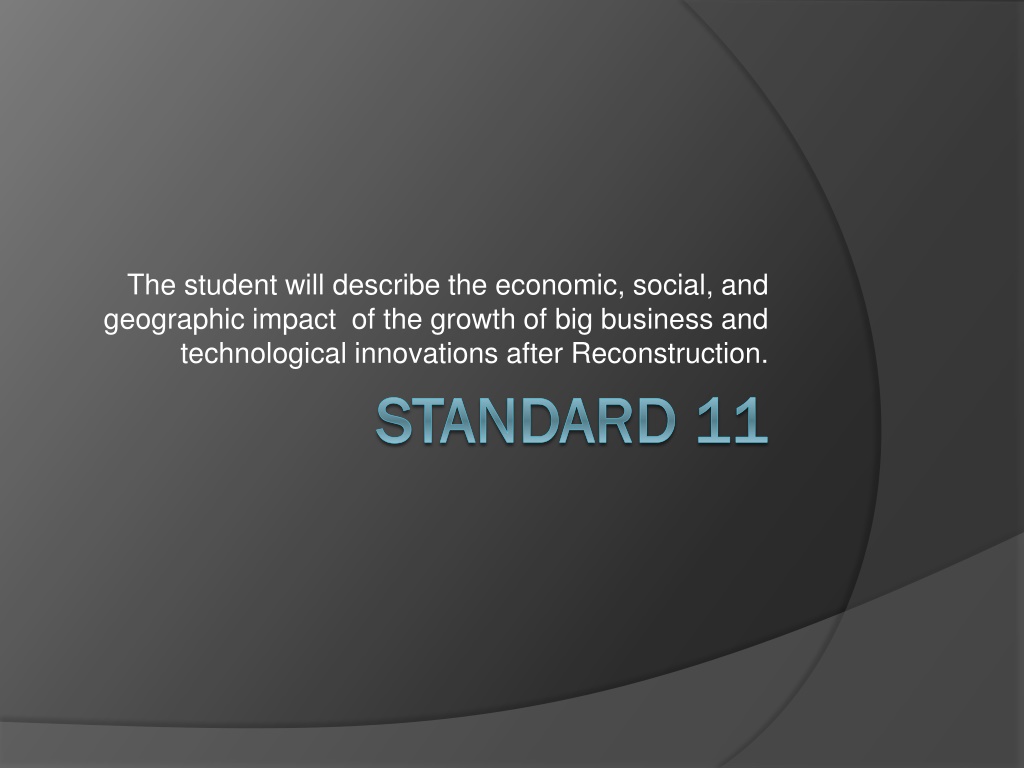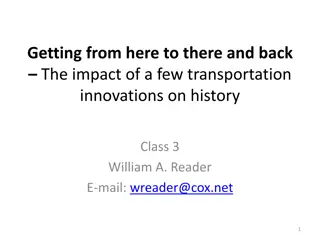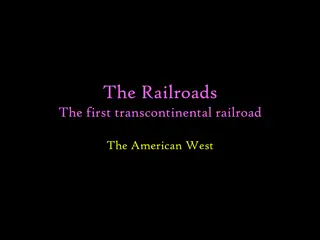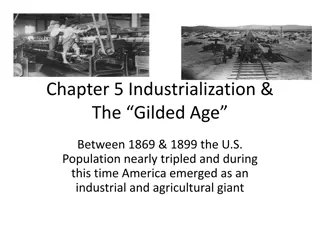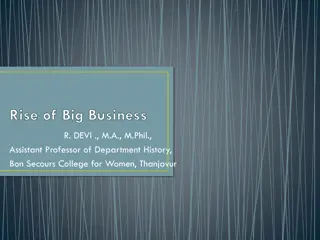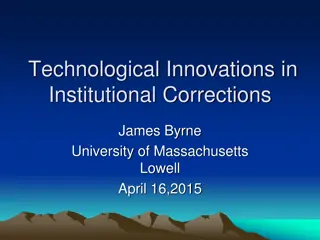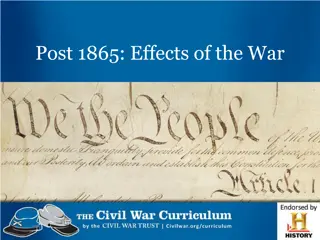Impact of Railroads on Big Business and Technological Innovations Post-Reconstruction
Railroads played a crucial role in the growth of big business and technological innovations after Reconstruction. They impacted industries like steel, leading to mass production and affordable products, and spurred the development of safety measures. Railroads also transformed business organization, requiring significant capital investment and trained managerial staff. The interconnectivity and advancements brought about by the railroads were instrumental in reshaping the economic and social landscape of post-Reconstruction America.
Download Presentation

Please find below an Image/Link to download the presentation.
The content on the website is provided AS IS for your information and personal use only. It may not be sold, licensed, or shared on other websites without obtaining consent from the author. Download presentation by click this link. If you encounter any issues during the download, it is possible that the publisher has removed the file from their server.
E N D
Presentation Transcript
The student will describe the economic, social, and geographic impact of the growth of big business and technological innovations after Reconstruction. STANDARD 11 STANDARD 11
a. Explain the impact of the railroads on other industries, such as steel, and on the organization of big business.
Impact of Railroads The railroads were the biggest customers for the steel industry Thousands of miles of steel track were laid. The railroads had a great impact on the steel industry
Impact of Railroads To supply their biggest customers, steel producers developed cheap, efficient methods for the mass production of steel rails These low-cost methods enabled more industries to afford the steel companies products
Impact of Railroads Other industries were also impacted Example: The Pullman Sleeping Car Was developed for the comfort of long distance travelers These cars needed: Glass for windows/cloth for seats/wood was needed for the car construction/bedding for the sleepers/a myriad other smaller fittings to hold the entire car together
Impact of Railroads To increase train safety Signal systems were developed Better braking systems were invented National time zones were created
Big Business The railroads were the single largest business in the United States It changed the way businesses were organized Huge amounts of capital were needed to create and maintain a nation-wide business This capital was acquired through both public (i.e., government) and private investments
Big Business Large professionally trained managerial staffs were needed to keep up with: Passengers Cargo Equipment
Big Business New means of accounting were created to track the large efficiencies needed for railroads to be Efficient Cost effective Profitable
Big Business Internal organization led in turn to the consolidation of the many railroads This was especially true as economic panics caused less profitable lines to collapse and were absorbed by larger, more profitable firms
b. Describe the impact of the railroads in the development of the West; include the transcontinental railroad, and the use of Chinese labor.
Immigrant Labor and the Railroads The construction of the transcontinental railroad would not have been possible without: A large labor supply of immigrant labor The public investment in railroads by land grants and guaranteed construction costs
Immigrant Labor and the Railroads Irish and German laborers constructed the rail route from east to west The owners of the Central Pacific Railroad initially brought European immigrants from the east Had trouble keeping them working due to the proximity of the gold fields Were building the line from California
Immigrant Labor and the Railroads The owners hired available Chinese labor in California and then brought in additional Chinese labor to complete the task Were paid approximately $28-$35 per month Compared to $50 the European worker earned Were doing very dangerous work of blasting and laying ties over the treacherous terrain of the high Sierras
Immigrant Labor and the Railroads Lived in simple dwellings and cooked their own meals Often consisting of: Fish Dried oysters Fruit Mushrooms Seaweed
Immigrant Labor and the Railroads The work was dangerous Many died in: The explosive blasts they ignited to cut the solid rock roadbed Under landslides and heavy snowfalls The first transcontinental railroad was completed in 1869
The Railroad and Expansion The federal government granted vast areas of western land to railroad owners Railroad right-of-ways were 10 miles wide, plus 400 feet So the railroads could sell the land to help finance the cost of construction The railroad companies contributed to the development of the West by selling low-cost parcels of their western land for farming
The Railroad and Expansion Settlers traveled west on the trains to farm on the fertile soil Western farmers used the trains to ship their grain east Western cattle ranchers shipped their steers to eastern butchers
The Railroad and Expansion Both farmers and ranchers sold their goods to people they could not easily reach without railroads The railroads earned money by transporting the settlers west and the goods east
c. Identify John D. Rockefeller and the Standard Oil Company and the rise of trusts and monopolies.
Rise of Trusts and Monopolies The period after the Civil War was a time when business concerns sought to maximize their profits by combining competing corporations into single entities These large companies would be able to control: Prices Production Sales Establish a monopoly
Rise of Trusts and Monopolies There were several individuals in this era who are known for the monopolies they created These include: Andrew Carnegie (steel) Cornelius Vanderbilt (railroads) Jay Gould (railroads) J.P. Morgan (banking and finance)
John D. Rockefeller Rockefeller was known for his: Economy Precision Foresight in creating one of America s landmark corporations-Standard Oil
John D. Rockefeller After obtaining a degree in business, Rockefeller started out a book-keeper and clerk in a wholesale grain and produce business in Cleveland, Ohio in 1855. His diligence and hard work won him great admiration. His idea of thrift gave him the capital to start his own wholesale grain business in the early 1860 s.
John D. Rockefeller Rockefeller realized that the growth of agriculture in the upper Mississippi Valley would eclipse Cleveland s role in grain sales He foresaw Cleveland s location could serve a clearinghouse for raw materials The newest commodity gaining in popularity and usage was oil In 1863 Rockefeller entered the oil refining business
John D. Rockefeller Oil had been discovered in Pennsylvania in 1859 In order for the oil to usable it needed to be refined into a distilled spirit kerosene Rockefeller began by developing a business that transported petroleum products Cut costs by: Creating his own a barrel-making factory Had is own horses and wagons to transport the petroleum products to market
John D. Rockefeller His practice was what is known today as vertical consolidation Creating a monopoly that consists of all elements of production from raw material to sale of the finished product
John D. Rockefeller In 1870 Rockefeller created Standard Oil He began to buy up inefficient refineries He closed those that were too expensive to renovate and improving those that showed promise By 1879 Standard Oil controlled 90% of the refining capacity in the United States
John D. Rockefeller When railroads proved inefficient for his needs he built a pipeline from the oil fields to the refinery In1882, Rockefeller combined his many companies into the Standard Oil Trust
The Trust Stockholders turn their shares over to a board of trustees They control and managed the different companies as a single company in order to achieve greater efficiencies Divide the profit up among the shareholders Enabled Standard Oil to monopolize all aspects of the oil industry From production to marketing In 1890 the Standard Oil Trust was broken up by the Ohio Supreme Court
Other Business Practices Pools (another early business combination practice) and Trusts were outlawed Interstate Commerce Act (1887) Sherman Anti-Trust Act (1892)
Other Business Practices Holding Companies When a parent company holds enough stock in smaller (competing) companies to be able to control the management and running of the smaller company
Other Business Practices Interlocking Directorates When one or more persons serves on the board of directors of several companies and thereby able to control the competing companies through his or her actions on each board
Other Business Practices Mergers The consolidation of two competing companies into a single trading company
d. Describe the inventions of Thomas Edison; include the electric light bulb, motion pictures, and the phonograph, and their impact on American life.
Thomas Edison The effects of technological advances made after Reconstruction forever changed how people lived The most famous inventor of the period is Thomas Edison Invented the electric light bulb, the phonograph, motion pictures, a system for distributing electrical power, and many other technologies powered by electricity
Thomas Edison Established the concept of industrial research Founded a research laboratory staffed by engineers and technicians in New Jersey Edison s technological achievements were used by other inventors As evidenced by the development of long- distance electricity transmission Which enabled Edison s electric light to illuminate buildings, streets, and neighborhoods across the United States
Thomas Edison Electricity soon replaced: Steam as the source of power for factories Horses as the means to power streetcars Humans as the source of power for household appliances
Thomas Edison Edison s inventions eliminated much manual labor that had been associated with everyday household activities and improved Americans quality of life
